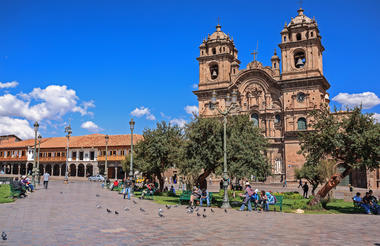Peru is most famous for the sacred archaeological site of Machu Picchu – visited each year by scores of intrepid hikers who brave the Inca Trail’s arduous slopes to explore the age-old ruins. The country’s attractions extend far beyond the mystical allure of this legendary location and include palm-fringed beaches, quaint Andean villages and archaeological treasures that predate Machu Picchu by hundreds of years – all imbued with the nation’s rich melange of indigenous and colonial cultures. Equally enticing are the exotic reaches of Peru’s Amazon rainforest; Lima’s superb eateries, exquisite architecture and effervescent nightlife; the glittering, mountain-ringed waters of Lake Titicaca; and the vibrant city of Cusco, referred to by the Incas as ‘the centre of the world’.
Peru’s capital is a fantastic city to tour, dotted with a multitude of cultural sites and beautifully preserved architecture. Founded by the conquistador Francisco Pizarro in 1535, Lima was first named ‘City of Kings’ – a biblical reference to the ‘Three Wise Men of the East’ – before its name was changed by the Spanish colonialists. The most significant historical buildings are located around the Plaza Mayor, the most notable being the Government Palace, where one can still observe the changing of the guard performed by the Húsares de Junín. The beautiful Cathedral and the various small palaces and colonial balconies also play also their part in the beauty of the city. Another highlight is the famed Larco Herrera Museum, documenting the millennial cultures that preceded the Inca civilization and containing a priceless collection of pre-Columbian artifacts, including some of South America's finest pre-Inca erotic pottery.
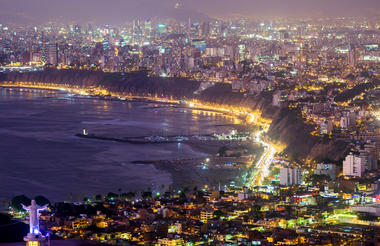
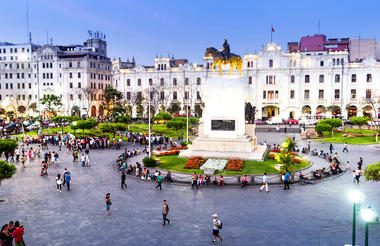
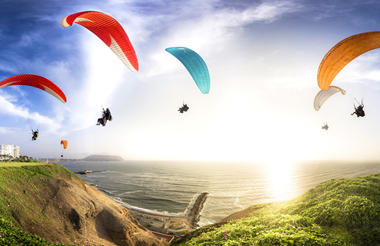
A lunar-like landscape meets the ocean at Paracas, a small beach town on the Paracas peninsula in southern Peru. Stark cliffs drop into the ocean and rugged promontories jut out to sea, offering a beachfront residence to the flocks of marine birds in the area. Many visitors travel to Paracas to enjoy the beaches and the perks of a resort town, however it’s the adjacent marine reserve and outlying islands that most intrigue travellers, offering the chance to view penguins, sea lions, dolphins and seals in their natural habitat. Don’t miss the Paracas Candelabra, a mystic geoglyph etched into the rock and dating back to 200 BCE.



Nazca is situated in the Southern Coast region of Peru. The town is famous for the UNESCO World Heritage Site, Nazca Lines: enormous zoomorphic drawings created in the desert by scratching away the top layer of rock and sediment to reveal lighter sand beneath. These mysterious, larger-than-life etchings are an unforgettable sight and should feature on any Peruvian travel itinerary. Other key attractions include the Nazca Channels (or Puquios) at Cantalloc – ancient underground aqueducts found near the Inca ruins of Paredones – and the interesting Museo Arqueologico Antonini, which provides great context and information about these archaeological sites. It also houses an excellent collection of Nazca ceramics and textiles (which are known for their vibrant colours and patterns).

The gorgeous city of Arequipa is a perfect blend of ancient architectural treasures and modern buildings, blessed with an average of 300 days of sunny weather a year. It is also known as ‘The White City’ – a nickname that stems from its numerous white buildings, which form a striking contrast with the green surroundings. It is Peru’s most elegant city and the best place to visit if you’re a foodie on the hunt for fine dining opportunities, with an array of fabulous restaurants offering spicy local specialities such as rocoto relleno, chupe de Camarones and ocopa. This city has an illustrious history and its distinctive traditions make it a truly unique Peruvian destination.



The town of Chivay is located in southern Peru. This popular destination is one of the most accessible within the world-renowned trekking area of Canon del Colca (the Colca Canyon), and offers some excellent cultural sights and outdoor activities. Begin at the stone Inca Bridge, which spans the Colca Ravine, and then visit the attractive Temple Santiago Apostol de Coporaque, before relaxing in the cafe-lined Plaza de Armas de Chivay. Nature lovers will relish the Astronomical Observatory, with brilliant views of the Milky Way available in the pollution-free valley, as well as the Andean condor-spotting area of Cruz del Condor. Finally, Hot Springs La Calera offers rejuvenating waters and a range of spa treatments, and further expeditions into the Colca Canyon (such as Tuti, Sibay and Callalli) are easily arranged from Chivay.



Set on the shores of glistening Lake Titicaca, on the Altiplano of Peru, this large city is dubbed the ‘folklore capital' of the country, well known for its traditional music and dance. It is also famous for its incredible collection of floating islands - man-made islands created from reeds, which exhibit the unique survivalist culture that has been alive here since pre-Incan times. Other highlights include visits to the atmospheric, historical Church of San Pedro, the gorgeous Sistine Chapel of the Americas, and a stroll along the boardwalk on the shoreline of Lake Titicaca. Active types should take on the challenge to climb up the 700 steps to the Kuntur Wasi viewpoint, which is presided over by a massive metal condor sculpture, for the reward of breathtaking vistas across the city and Lake Titicaca beyond.

Home to ancient traditions and cultures that are fast disappearing, Bolivia is the continent’s most indigenous country, with 60% of its inhabitants descended from Native Americans - a rich heritage that is evident in the local art, cuisine, music and traditions. Equally as fascinating is the incredibly diverse landscape, stretching from the central Andes to the Amazon Basin and encompassing a terrain that includes snowy peaks, the world’s highest navigable lake, rainforests, dry valleys, and volcanoes both active and extinct. Whether you are in search of colourful festivals, ancient remains or an outdoor adventure, Bolivia is a tourist’s treat waiting to be discovered.
Surrounded by the peaks of the Andean Plateau and overlooked by the 6402m Mt. Illimani, La Paz is a truly breathtaking city whose buildings sprawl across the surrounding canyon, reaching altitudes of up to 4100m. While the sight of the city is reason enough to visit, La Paz holds a number of attractions sure to keep tourists fascinated. Take a walk along Calle Jaen, a colonial street lined with museums, explore the city's cathedrals or wander through some of the colourful markets, including the 'Witches' Market' where llama foetuses and dried frogs can be found for sale.



Situated in the Bolivian province of Daniel Campos, the town of Tahua and the surrounding eponymous municipality is home to some of the most spectacular landscapes in South America. The area is dotted with tiny Bolivian villages, blanketed with an endless white salt plain and covered with mountains rising from a lunar-like landscape. Resting at the foot of the sacred Tunupa Volcano, the little village of Tahua sits on the edge of the world’s largest high altitude salt flat, the Salar de Uyuni, which is undoubtedly the main highlight in the province. This vast salt desert is one of the most awe-inspiring spectacles in the country. Visitors will find a variety of wildlife living in and around this area including flamingos, rheas, vicunas, and foxes. Don’t miss the fascinating Fish Island, featuring a rocky island outcrop comprised entirely of fossilized coral and scattered with giant prehistoric cacti.



The Siloli Desert is the world’s highest desert, resting at an altitude of 4550 metres above sea level. It is located close to Bolivia’s border with Chile and considered to be an extension of the neighbouring Atacama Desert. Visitors to this remote part of the world can look forward to dramatic views of geometrically cracked salt pans and rust-coloured hills. The desert’s most iconic feature is the Árbol de Piedra, a seven-metre high sandstone formation that resembles a gnarled tree and was shaped by the region’s harsh winds over thousands of years. The tiny settlement of Ojo de Perdiz has a spattering of guesthouses and a fascinating community, while the nearby Pastos Grandes Lagoon is a shallow salt lake set below a volcanic mountain where you can see flocks of flamingos and revel in the breathtaking scenery.



Located in the southwest of Bolivia, the small town of Uyuni is not a tourist destination per se, but rather a starting point for those wishing to explore the region’s extraordinary landscape. Group tours leave regularly from Uyuni, taking visitors on a scenic journey that includes an antique train cemetery, thermal baths, rock formations, and the remarkable Uyuni salt flats. Spanning more than 10 000 square kilometres and containing 10 billion tonnes of glistening salt, 'Salar de Uyuni' is the world’s largest salt plain, offering breathtaking views that place it amongst Bolivia’s main attractions.



As previously described
Peru is most famous for the sacred archaeological site of Machu Picchu – visited each year by scores of intrepid hikers who brave the Inca Trail’s arduous slopes to explore the age-old ruins. The country’s attractions extend far beyond the mystical allure of this legendary location and include palm-fringed beaches, quaint Andean villages and archaeological treasures that predate Machu Picchu by hundreds of years – all imbued with the nation’s rich melange of indigenous and colonial cultures. Equally enticing are the exotic reaches of Peru’s Amazon rainforest; Lima’s superb eateries, exquisite architecture and effervescent nightlife; the glittering, mountain-ringed waters of Lake Titicaca; and the vibrant city of Cusco, referred to by the Incas as ‘the centre of the world’.
Once called the ‘Navel of the World’ by the Incas, Cusco rises in the southern Andes of Peru, where colonial grandeur meets the enduring stonework of the Inca Empire. A UNESCO World Heritage Site, it serves as the main gateway to Machu Picchu, the Sacred Valley, and surrounding ruins. At its centre, the Plaza de Armas—once Huacaypata—remains alive with cafés, arcades, and the 16th-century Cusco Cathedral, built from Sacsayhuamán’s stones. Nearby, the San Blas district unfolds with whitewashed adobe houses, blue balconies, and workshops where artisans craft metalwork, woodcarvings, and sacred art. Across the city, layers of history reveal themselves in landmarks such as the Korikancha, the Inca street of Hatun Rumiyoc with its twelve-angled stone, the Museum of Colonial Art, and the ancient shrines and water temples scattered through the surrounding hills.



Also known as Urubamba Valley, the Sacred Valley of the Incas is located in the Peruvian Andes, beneath the world-famous site of Machu Picchu and not far from Cuzco, the unofficial Inca capital. This fertile valley is fed by a network of waterways and encompasses a wealth of archaeological sites, including Ollantaytambo, renowned for its extensive Inca ruins; Tipon, which features ancient agricultural terracing and a working irrigation system; and Pisac, with its ancient vestiges and colourful weekly market.


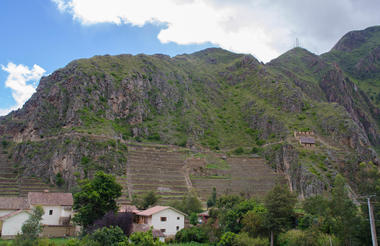
Perched high up in the Andes, Machu Picchu Pueblo is a riverside town known for its proximity to the famous Machu Picchu ruins. This cloud-forest town is encircled by towering forested cliffs and boasts an endless array of hotels, restaurants, markets and labyrinthine streets. Machu Picchu Pueblo, also known as Aguas Calientes, serves as an excellent base to explore the renowned ancient archaeological site of Machu Picchu. Visitors can enjoy various other activities, including having a relaxing massage after a long day of exploring, taking a stroll through lush rainforest to the Mandor Waterfalls, embarking on an adventurous hike up the Putucusi Mountain or soaking in the relaxing thermal baths with the Andes as your backdrop. Don’t miss the Machu Picchu Museum and Botanical Gardens, displaying the area’s history and diversity of indigenous flora.
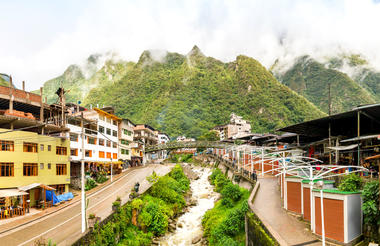
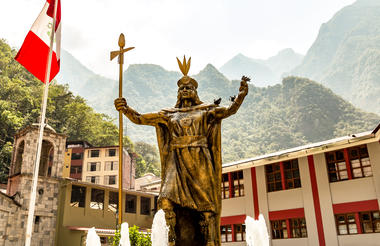
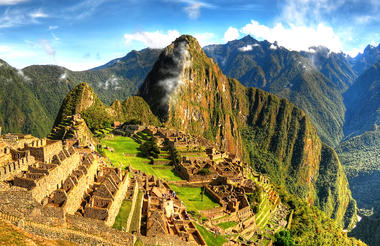
As previously described


